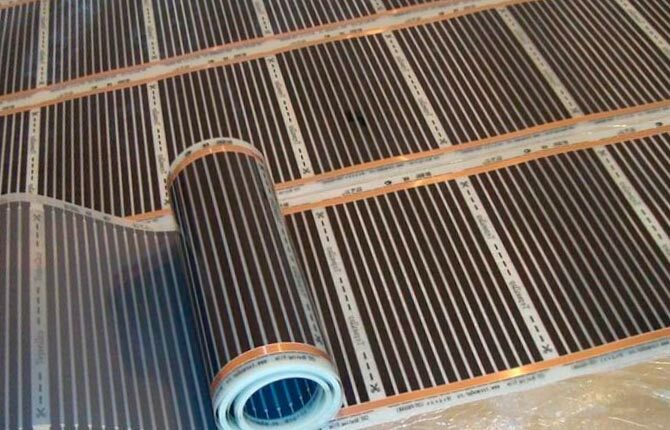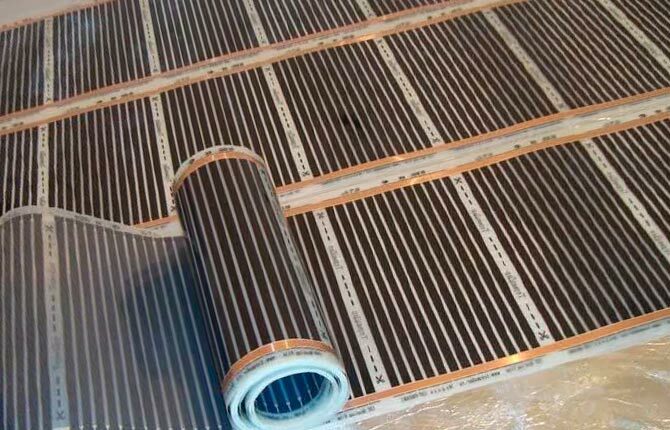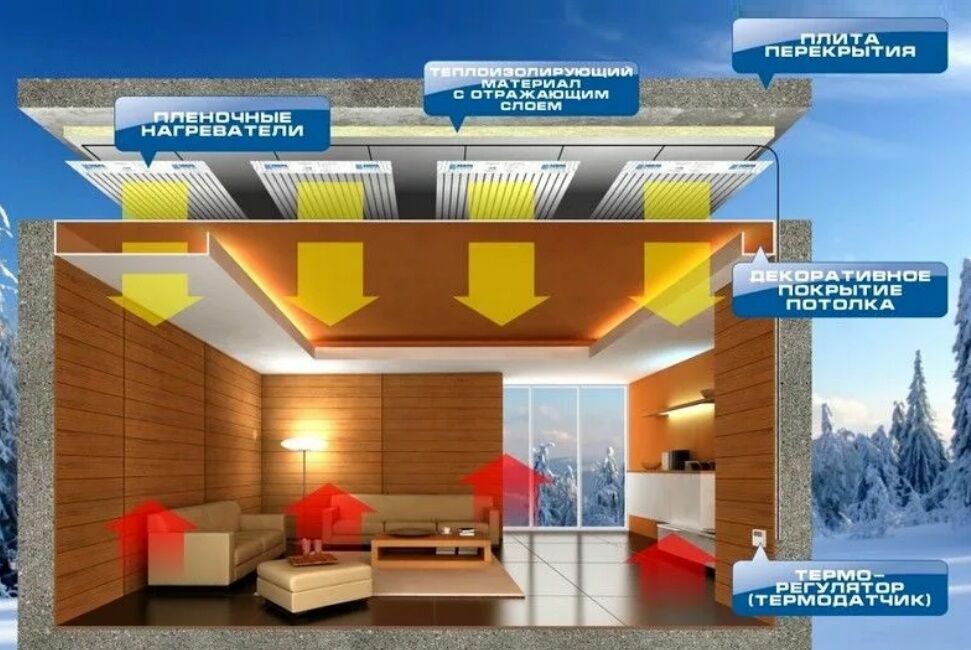Equips water floor heating system in a country house and it is time to lay to insulate the substrate? You will agree that among the variety of offers thermal insulation materials offered by manufacturers, sometimes not easy to make the right choice.
We will help you determine which heater for warm water floor better. Together with you, we shall understand all the nuances of the assembly of thermal insulation systems. We investigate the characteristics of popular materials, evaluate the key advantages and disadvantages.
Independent handyman we will find installation instructions. Make it easier to navigate the range of products offered by the market of building materials, we picked up videos with advice on selecting and installing insulation.
The content of the article:
- The need for thermal insulation system
-
Types of heaters under Radiant Floor
- Option # 1 - insulating plates
- Option # 2 - profile system with guide
- Option # 3 - roll insulation performance
-
Features of laying insulation
- №1 - laying technology tiles
- №2 - installation of roll materials
- №3 - mounting design mats
- Conclusions and useful videos on the topic
The need for thermal insulation system
In any installation of water floor heating instructions for independent artists indicated that it is necessary to use a heater.
A layer of insulation in the regeneration water floor performs several important functions. It helps not only to ensure uniform heating of the room, but also by acting as a heat shield allows you to significantly reduce the energy losses of the system.
Plate, laid on top of the insulating layer acquires properties whole heat transmitting member having a large surface area.

The main purpose of the insulating layer - evenly distribute the heat in the room heated by preventing its leakage through the floor slab
Due to the uniform distribution of energy, regulated convection heat flux starts to move at the same speed and in the same direction. As a result, evenly distributed heat waves will not be on the floor to form a hot and cold areas, creating favorable conditions for households.
Moreover, due to the direction of the warm air flows on one course it is possible to reduce power consumption for operation of the system, while retaining its capacity unchanged.
modern insulating mats equipped with comfortable snaps as bosses, with which the laying of pipes with subsequent fixation can be done quickly and at the same time reliable.
image gallery
Photo of

The construction of the thermal insulation layer beneath the water floor heating systems are used rolled soft and rigid board materials. Roll easier in the packing, but are less effective for heat engineering criteria

Among the embodiments of plate heat insulation is most commonly used, extruded polystyrene foam, the structure of which virtually eliminates absorption and moisture retention

Organization of the insulation floor component of the system of non-extruded polystyrene foam, ie foam requires compulsory waterproofing layer on top of that do not necessarily obtained using extrusion material

To facilitate the procedure, the device floor heating pipe is better if the outer surface of the plates have markings

The most simple and convenient to use insulation option are now the polystyrene plate with a raised pattern, performing a lot of useful functions

Boss polystyrene mats provide a clear and fast to install underfloor heating pipe according to the selected pattern, playing the role of the markup

Relief polystyrene plates serves as a support for gipsovolokonnyh plywood or boards when performing dry screed

In areas within which it is impossible to observe the calculated step during installation, used for insulation of pipes, excluding zone superheat surface

Roll substrate for underfloor

Expanded polystyrene insulation in the installation

Foam insulation

Foil plates with factory markings

Warming of the polystyrene mats with bosses

Pipe installation with the required step

Formation distance for dry Staszko

Application penofleksa pipe
Types of heaters under Radiant Floor
Options heaters for outdoor water heating system on the market today presented a lot. Selecting the thickness of the substrate is limited only by physical facilities owner and technical parameters of the premises.
Absolutely all insulation materials impede movement through its thickness of the sound waves, and therefore characterized by high levels of noise absorption.

If a base core is heated area sufficient insulation at a thickness of 10-12 mm, if the basement or ground - require support from 30 mm and more
Regardless of the embodiment of a heat insulating material, special requirements:
- it must have a low coefficient of thermal conductivity;
- posed perceive tubes filled with water load;
- load carrying screed laid over a pipeline;
- be resistant to dynamic effects which may occur during operation of the system, and after pressure reduction it has to take the original shape.
To achieve the desired effect allows the use of insulated material whose density is not less than 35 kg / m3.
Option # 1 - insulating plates
In areas where the ceiling height reaches 260 centimeters and above, you can safely give preference of heaters on a rigid polymer-based.
Foam or polystyrene foam. The basis for the manufacture of insulation boards can act foam or polystyrene foam.
First Embodiment created neekstruzionnym manner between its polymer cells have channels for the passage of air and steam. Foam differs low specific weight and high vapor permeability.
In the manufacture of polystyrene foam extrusion method is used, whereby the material of the cell walls firmly sintered to each other. Water vapor permeability of a heater because it is practically zero. But it has a high strength and ability to withstand significant mechanical loads.
The specific heat capacity of polystyrene is slightly higher than that of the foam. In the first case it is equal to 1.34 kJ / (kg ° C), the second calculated 1.26 kJ / (kg ° C). The difference is small, but the calculations can significantly affect the overall thickness of the floor heating system.
Standard size thermal insulation sheets PenoplexFor example, 120 cm × 240 cm. GOST 15588-86 numbered regulated width from 50 cm to 130 cm, the length from 90 cm to 500 cm.
The density of the foamed polystyrene 150 kg / m³, the same characteristic foam 125 kg / m³. Depending on the specific production and properties invested manufacturers in the production, characteristics of the materials are subject to change.

Due to the unique composition of polystyrene plates serving good shumoizolyatorami and their load capacity is about 50 kN / m
If you compare both types of material, the foam is disadvantageous in that the yield extrusion product in terms of density. Due to this, it is less resistant to deformation under the action of mechanical stress.
From this greatly reduces its thermal insulation properties. Foam recommended to lay in systems designs grazing between joists.
cork. Often, as insulating substrate under water and electric floors used cork. Due to its special structure, which is a miniature prisms regular shape, suberic insulation has considerable compressive strength and lack of adhesion to the cement solution.
Due to the high cost of cork material frequently chosen for premises in which a basic foundation and so well insulated. Otherwise to achieve the desired technical effect is required to acquire a stopper at least 30 mm thick, which can essentially "punch on the wallet."

The main advantage of mats made of several layers of fibers glued cork oak bark is environmentally safe
The only drawback cork mats is that they are hygroscopic and also available as single-component heat insulators. So when stacking is necessary to use an additional layer that will provide steam and hydraulic protection.
Mineral wool. As an alternative option is available at a cost - the use of mineral wool. It is produced in the form of a flexible mat or a solid plate.
Since the installation in mortar mineral wool is crushed under the weight, which is detrimental to its heat-shielding properties, this material is also better to combine with grazing structure assembled from wooden log.

With the use of mineral wool as a heat insulating layer, heat transfer water floor heating is maximum
The only drawback of the material - the presence in the penofol, which carries a risk to human health, and low moisture resistance. But competently performed waterproofing easily eliminates these drawbacks.
Option # 2 - profile system with guide
Facilitate the installation process water circuits help profile systems. They are created using gidropellentnoy stamping technology, which resulted in formed shaped protrusions.
Products are of two types: conventional and laminatedWhich are covered with insulation film.

Boss or guide grooves are located on the surface of the profiled mats in neat rows, between which is convenient to stack heats contours
The basis for the manufacture of extruded polystyrene protrudes, which is created by extruding the molten composition through an extrusion orifice.
Polymer base famous resistant to moisture and high mechanical strength. Best plate thickness may vary between 10 and 35 mm. The main thing - that it was proportional to the thickness of the final tie.
The side faces of each plate are equipped with locks, through which it is convenient to carry out adjustment elements, forming a continuous field devoid thermoacoustic seams.
Height of cylindrical protrusions located on the surface of the plates, is about 20-25 mm. That's enough to comfortably accommodate and secure the water circuits with a diameter of 14 mm to 20 mm. Closefitting series of bosses exclude the possibility shear stacked contours during pouring of cement screed.

The only drawback of profile systems is not possible to stack them in the water circuits, pipes made of non-standard diameter
A feature of the installation profile systems is that after laying them water circuits are filled with top design with a thin layer of adhesive. And only after a day or two, when the glue is completely dry, the system start-up.
image gallery
Photo of

The building insulation is advisable to use warm floors ready for installation polystyrene plates with mounting hardware

The edge of the heat insulating plate is provided with a lock to form a firm connection and eliminate the possibility of heat leaking through the joint

Bosses pipe installation systems provide the optimum angle for the movement of coolant, whereby these problematic areas is not reduced passage capacity

The use of mats with raised ridges to facilitate stacking, allows a rapid pace to build on any circuit system

Polystyrene boards with bosses

on the edge of the insulation board lock

Formation of a smooth corner bend pipes

Heated floor assembled
Option # 3 - roll insulation performance
Rolling heaters opt for premises in which the distance to the ceiling is critical. Using thin foil layers with a protective Mylar coated can significantly reduce the thickness of the "pie". The maximum thickness of the substrate is only 9-12 mm.

Damage on the one hand a good layer of insulation foil reflecting heat radiation, thus preventing energy losses
Roll insulation fitted with heat reflecting coating of Dacron or thermal. Thin metallic materials perfectly reflects heat rays, so you can safely reduce the thickness of the insulation without fear of decline in insulation qualities.
An important requirement when using foil options is that you can not use materials with aluminum foil in the construction of floors with cement-sand screed. Alkaline medium mixture by pouring a layer of aluminum will corrode.
However, if the foil is applied on top of the protective film, stacking is possible. Allowed to use if the solution is mixed with the cast, and not on the cement powder. Some manufacturers substitute lavsan layer foil or polypropylene film, adding a metallic inclusions.

In an effort to ease the installation process, many manufacturers is applied to the foil side produced roll materials, mark protruding guide for laying heating contour
Less foil materials is that they reflect well the heat, but not well isolated. If the floor is laid over a basement, thin roll-making is not enough.
Some artisans solve the problem, for insulating hard paving mats are not in a single layer, but two. But in this case the sheets are placed so that the lower substrate overlap seams top seams. This helps to minimize heat loss.
Features of laying insulation
The circuit substrate assembly depends on the type of materials used. But in any case, it must be placed on the most level surface.
№1 - laying technology tiles
The substrate, being constructed from plates with mounting facet, going easily - by the principle of design. Plates comfortable fit and measure. Cut the slab under the appropriate size can be an ordinary knife.
Easy stacking substrate is convenient in that during assembly at any time to change the configuration of circuits and pipe length. To the plate material during installation and operation are not shifted relative to each other, their construction joints glued tape.

In order to prevent the formation of heat conducting bridges, contour joints between juxtaposed slabs glued tape foiled
The sequence of performing steps when installing insulation boards:
- On scraped and leveled base plates laid foam, fixing them by means of special plastic staples, dowels or anchors landing on the adhesive composition.
- And stacked on top of stacked plates line the foil layer.
- Topsheet lining reinforcing mesh, which is mounted in the latter and the tube.
If the concrete base floor screed is filled with significant deviations from the same level or has rough cracks and fissures, or concrete slabs are laid with violations, prior to laying the substrate is best to build frame. For this wooden joists collected on dry and smooth bar section 50x50, or 100x100 50x100 mm.

Lags placed equidistant at a distance of 60 cm therebetween paving cuts of mineral wool or foamed plastic slabs
A distance of 60 cm between the joists is considered the best option, since in this "step" is not necessary to create additional batten. The main thing - that the logs were located in the same plane and were strictly on the level.
Insulation boards must be tightly packed between the wooden logs. If there are gaps - they must blow out with foam.
In laying the slabs of extruded polystyrene is necessary to observe some of the nuances:
image gallery
Photo of

Cutting of plate heater is on site upon location-based communications previously arranged

Plates are arranged so that there was no cross-shaped sostykovok, ie vrazbezhku, as laid bricks in the wall construction

Damping tape mounted along the perimeter of the device after the heat-insulating layer. The edge you need to have a partially by insulation, is partially located on the wall

Above extruded polystyrene optionally lay waterproofing. However, the substrate with cells lined facilitate installation of pipes with a necessary step

Cutting boards of extruded polystyrene

Location on the principle of brickwork

Installing the damper tape around the room

Waterproofing with factory markings for assembly
№2 - installation of roll materials
Laying the web material is carried out at carefully leveled base and fixed to the base via the base tile adhesive or double-sided tape. Cutting strips of the desired size stationery operate ordinary scissors.
To compensate thermal expansion covering, foil layer should be placed with little entering the wall.

Metal foil material placed face up so that the metallized surface well reflecting the heat
When laying the roll materials are guided by the markings printed wiring layout. It defines the distance between circuits and facilitates pipe installation. Typically, web materials are at the edges of the polymer film and foil allowances for the possibility of connecting the adjacent webs.
When installing cuts pay special attention to temperature seams. To do this, the joints stacked strips glued-way construction or metallized tape. If the substrate is used as a cork, before laying it is necessary to take care of a reliable steam and waterproofing.
№3 - mounting design mats
Step before laying the mats, a waterproofing membrane arrangement. After laying it around the room along the bottom of each of the damper walls glued strip tape.
On the prepared base lining mat, bonding plates to each other through the locking system. To securely fasten plates of small thickness and low weight, use adhesive method and involve the plastic bracket-harpoons.

Some manufacturers for ease of installation, complete with tatami applied edge strips with which to mark up parts of comfortable leaving the heating zone
An important point: when laying the mats are not allowed to use metal fasteners, as it can damage the integrity of not only the thermal insulator, but also waterproof.
Choice of optimal basis for the insulating substrate depends on your ability. Yes, a good substrate cost is not cheap. But it will greatly enhance the functionality of the equipped system water sexes.
Conclusions and useful videos on the topic
Video # 1. Choosing insulation under cement screed:
Video # 2. An illustrative example of laying of mats:
Video # 3. Installation of the roll of insulation:
Not to be mistaken in choosing a water heater for floor, refer to the technical characteristics of the room, taking into account not only the thickness of the product, but the maximum Compressive load.
Properly approached the selection of a heat insulator and in compliance with all the subtleties of the installation, you will be able to create a sound basis for improvement of functional water underfloor heating system.
Want to tell about how to chose and placed a heater under floor heating at home? Any questions or valuable advice? Please write comments in the box located below.


